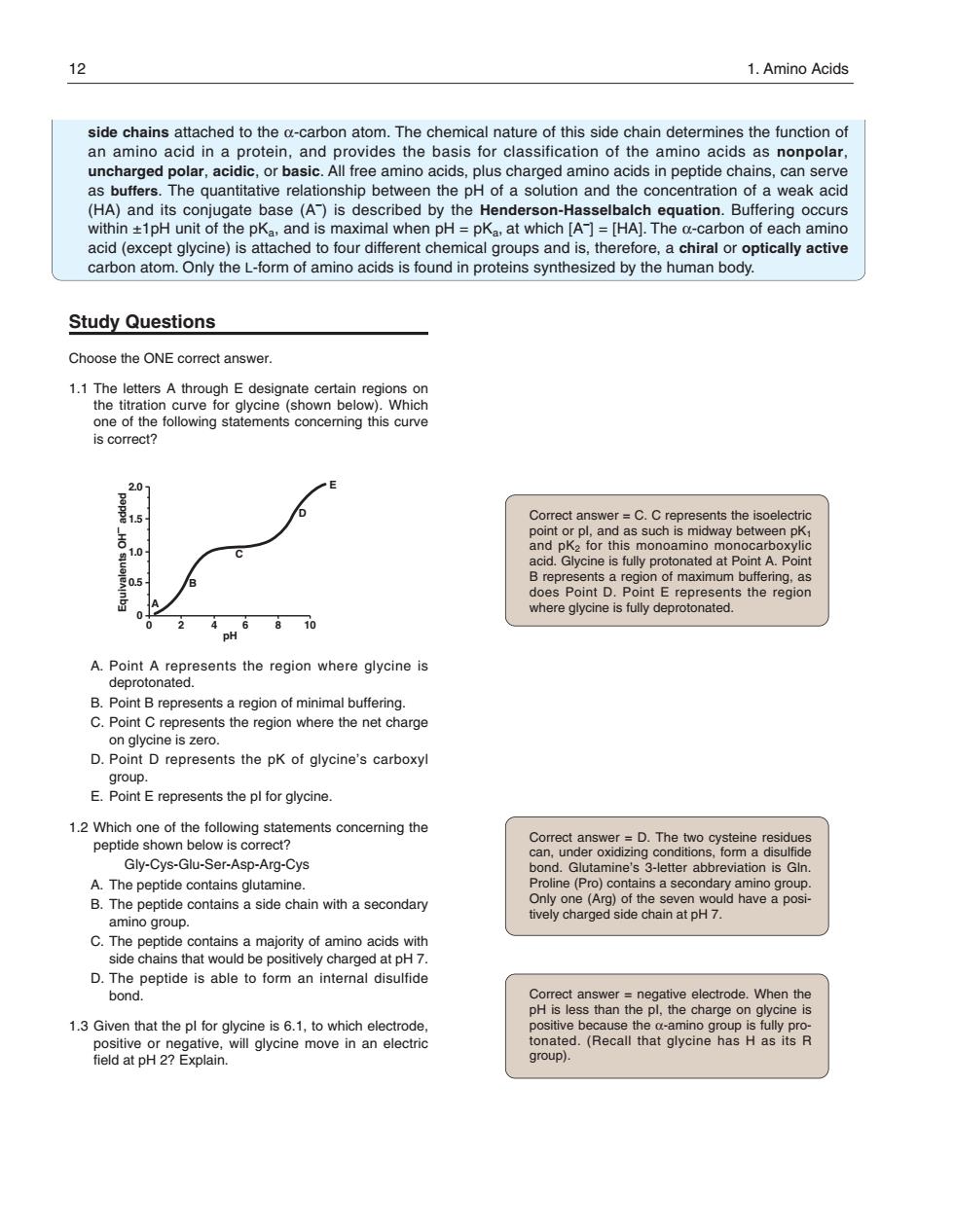正在加载图片...

12 1.Amino Acids side chains attached to the caon atom.The chemical nature of this side chain determines the function of uncharged polar,acidic.or basic.All free amino acids.plus charged amino acids in peptide chains.can serve as buffers.The quantitative relationship between the pH of a solution and the concentration of a weak acid (HA)and its conjugate base (A)is described by the Henderson-Hasselbalch equation.Buffering occurs within +1pH unit of the p -carbon of each amin acid (excep our a oups a e,a chira eins synthesized by the human body Study Questions Choose the ONE correct answer. 1.1 The letters A through E designate certain regions on is correct? Correct answer =C.C represents the isoelectri ay between p 05 tmaemgmbier,8 where ine is 24 B.Point Brepresents a region of minimal buffering. C.Point C represents the region where the net charge D.Pg2Nnes ents the pK of glycine's carboxyl Epoelorgce 1.2 Which one of the following statements conceming the pepti A Th amino group roup). Correct answer = C. C represents the isoelectric point or pI, and as such is midway between pK1 and pK2 for this monoamino monocarboxylic acid. Glycine is fully protonated at Point A. Point B represents a region of maximum buffering, as does Point D. Point E represents the region where glycine is fully deprotonated. Correct answer = D. The two cysteine residues can, under oxidizing conditions, form a disulfide bond. Glutamine’s 3-letter abbreviation is Gln. Proline (Pro) contains a secondary amino group. Only one (Arg) of the seven would have a positively charged side chain at pH 7. Correct answer = negative electrode. When the pH is less than the pI, the charge on glycine is positive because the α-amino group is fully protonated. (Recall that glycine has H as its R group). 12 1. Amino Acids side chains attached to the α-carbon atom. The chemical nature of this side chain determines the function of an amino acid in a protein, and provides the basis for classification of the amino acids as nonpolar, uncharged polar, acidic, or basic. All free amino acids, plus charged amino acids in peptide chains, can serve as buffers. The quantitative relationship between the pH of a solution and the concentration of a weak acid (HA) and its con jugate base (A–) is described by the Henderson-Hasselbalch equation. Buffering occurs within ±1pH unit of the pKa, and is maximal when pH = pKa, at which [A– ] = [HA]. The α-carbon of each amino acid (except glycine) is attached to four different chemical groups and is, therefore, a chiral or optically active carbon atom. Only the L-form of amino acids is found in proteins synthesized by the human body. Study Questions Choose the ONE correct answer. 1.1 The letters A through E designate certain regions on the titration curve for glycine (shown below). Which one of the following statements concerning this curve is correct? A. Point A represents the region where glycine is deprotonated. B. Point B represents a region of minimal buffering. C. Point C represents the region where the net charge on glycine is zero. D. Point D represents the pK of glycine’s carboxyl group. E. Point E represents the pI for glycine. 1.2 Which one of the following statements concerning the peptide shown below is correct? Gly-Cys-Glu-Ser-Asp-Arg-Cys A. The peptide contains glutamine. B. The peptide contains a side chain with a secondary amino group. C. The peptide contains a majority of amino acids with side chains that would be positively charged at pH 7. D. The peptide is able to form an internal disulfide bond. 1.3 Given that the pI for glycine is 6.1, to which electrode, positive or negative, will glycine move in an electric field at pH 2? Explain. 0 2 4 6 8 10 0 1.0 2.0 pH Equivalents OH– added 0.5 1.5 A B C D E 168397_P001-012.qxd7.0:02 Protein structure 5-20-04 2010.4.4 9:45 AM Page 12